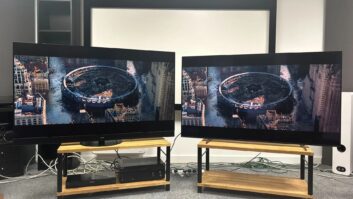Osaka, Japan – Panasonic Corporation revealed a management plan that covers the next three years, from April 2010 to March 2013, featuring CE products and green electronics.
Panasonic president Fumio Ohtsubo unveiled the plan, called GT12 (Green Transformation 2012), that is designed to fill Panasonic Group with strong growth potential, the company said.
Panasonic said in a statement that it aims to become the No. 1 green innovation company in the electronics industry by 2018, the 100th anniversary of its foundation. As the first step toward the goal, Panasonic will devote the next three years to making group-wide efforts in shifting its paradigm for growth and laying a foundation to be a green innovation company, while integrating its contribution to the environment and business growth. By the time this plan is complete in the fiscal year ending March 2013, Panasonic Group should be a company filled with significant growth potential, the company said.
Among the goals of the plan, Panasonic aims to reach 10 trillion yen or more in sales, record 10 percent or more in operating profit, and boast multiple key products that hold a top market share in the world. Panasonic will also enhance its contribution to the environment, laying the groundwork to be No. 1 in green indexes. The company intends to claim a top status among the following factors: contribution in CO2 emission reductions and recycling resources, the size of its energy systems business, and a sales ratio of No. 1 environmentally conscious products, Panasonic said in a statement on the same day it released its fiscal year results.
Growth will be driven by six key businesses, including network A/V and LED.
Panasonic is aiming for 2.15 trillion yen in sales for fiscal 2013 with an average annual growth rate of 10 percent.
The company will make its flat-panel TV business profitable by strengthening its competitiveness in terms of cost structure, product and marketing.
To increase the profitability of flat-panel TVs, Panasonic will improve its cost structure by shifting its finished product and module assembly to Asian countries, halving the number of components and actively adopting OEM and ODM services.
Panasonic will shift its emphasis to 3D TVs and LED-backlight LCD TVs and carry out intensive advertising investment in major countries as well as increase the number of products for high-volume segments.
Panasonic plans to produce 30 million units of flat-panel TVs in fiscal 2013, which compares with 15.8 million units produced in fiscal 2010. Of the 30 million units, the company intends to produce more than 11 million units in the emerging markets.
The company will also strengthen competitiveness of its flat-panel TVs. It is determined to make the Panasonic brand synonymous with 3D TVs and increase the ratio of 3D TVs to 70 percent of the total flat-panel TVs in fiscal 2013.
With regard to LCD TVs, the company will emphasize its LED-backlight TVs, introducing this year LED models that offer the industry’s top-class power saving performance.
In the LED business, Panasonic plans to increase sales by 4.5 times compared with sales in fiscal 2010. To achieve the goal, the company will promote its global expansion, establishing an overwhelming market share in Japan and actively developing overseas sales channels.
In the digital still camera business, Panasonic means to be one of the industry’s top three makers by achieving sales of 20 million units per year. In the digital interchangeable-lens system camera business, the company strives to achieve the world’s smallest and lightest camera.
Establishing a dedicated marketing structure for its single-lens cameras in each major region of the world, Panasonic will target a market share of 10 percent or more in the segment. In the compact camera category, Panasonic aims to capture new demand mainly in emerging countries by strengthening its lineup through collaboration with Sanyo.
Further, Panasonic will advance its black-box technologies in lenses and optical image stabilizer to build a super-thin, super-light and super-high picture quality cameras.













